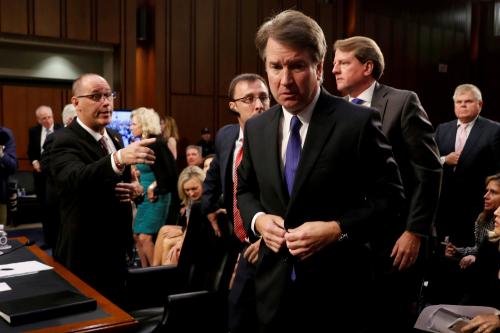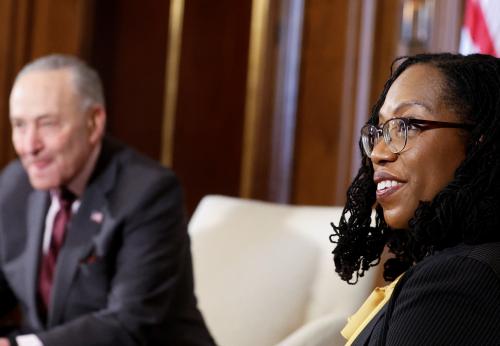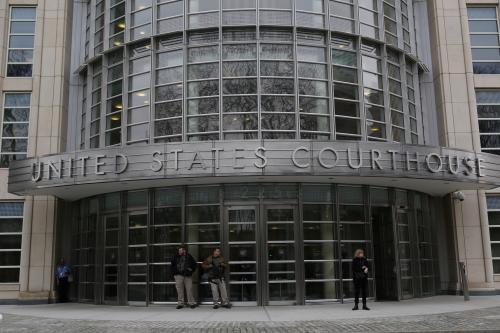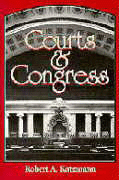President Donald Trump announced Monday night that he was nominating Brett Kavanaugh to replace retiring Justice Anthony Kennedy, touching off a confirmation process that will shape the Supreme Court for years to come. Now that we have a nominee, here is what to expect next.
What should we expect from the hearings?
The next big formal step in the Senate’s consideration of Kavanaugh will be his confirmation hearings. Confirmation hearings have come under fire in recent years as “empty” and “useless,” revealing little new, substantive information. To the extent that judicial nominees are asked to discuss their judicial philosophies in confirmation hearings, research suggests that minority and female nominees are pressed to do so more—indicating that a nominee like Kavanaugh might face fewer such questions. In addition, as work from Maya Sen and William Spaniel argues, a like-minded Senate and president can benefit from keeping the nominee’s preferences opaque, as it makes it harder for the nominee to be exposed as sharing the president’s views.
Do Democrats have procedural tools they can use to obstruct the nominee?
Since Kennedy announced his retirement, there has been discussion of whether Senate Democrats should play “procedural hardball” to try to defeat Trump’s nominee. Indeed, there are certain things Democrats could try in order slow action in the Senate as a means of obstruction. Matt Glassman discusses some, such as objecting to all unanimous consent requests, here. Greg Koger explores the possibility of denying the Senate a quorum, or a sufficient number of senators to conduct business. Importantly, however, a sufficiently determined Republican majority would have procedural tools at their disposal to undo what a Democratic minority would try, and it’s unlikely that Republicans would go quietly in the procedural good night in the face of a challenge from Democrats. Judicial confirmations have been central to the Republican agenda under President Trump, and during the debate over confirming Neil Gorsuch in 2016, Republicans tended to have more intense preferences in favor of the nominee than Democrats did in opposition.
If not procedural hardball, then what?
The major terrain on which the debate over Kavanaugh will be fought, then, is not procedural, but political. How this is likely to proceed is relatively straightforward. There will be pressure on Senators Susan Collins (R-Maine) and Lisa Murkowski (R-Alaska) to oppose the pick on grounds related to Roe v. Wade. Senator Rand Paul (R-Ky.) will be watched closely for potential opposition on civil liberties issues. On the other side of the aisle, Democrats from states Trump won who are up for re-election this fall, like Senators Joe Manchin (D-W.Va.), Heidi Heitkamp (D-N.D.), and Joe Donnelly (D-Ind.), will be targeted as potential supporters of the nominee. Early indications suggest that TV ads will be a major part of the effort to mobilize voters around the issue. As I’ve shown in research with Rick Hall, while ads are often used to try to mobilize allies, the SCOTUS fight is ripe for ads meant to persuade undecided senators; we demonstrate that ad campaigns meant to persuade are more likely when a roll call vote is imminent and expected to be close.
What will ultimately matter for how senators vote? As Michele Swers wrote last week, decisions are about more than just whether senators share the policy preferences of the nominee; party loyalty and electoral pressures can also play a large role. Other research, from Jonathan Kastellec, Jeffrey Lax, and Justin Phillips, highlights the role of public opinion. The greater support for confirmation in a senator’s home state, the more likely it is the senator will vote for the nominee—even accounting for other factors, like partisanship, that generally affect senators’ voting behavior.
When is this all going to happen?
Republicans have indicated they want things to proceed quickly. Senate Judiciary Chairman Chuck Grassley (R-Iowa) said in an interview last week that a confirmation before the Court begins its new session in early October is possible. The extremely large volume of documents related to Kavanaugh’s career—reported to run into the millions of pages—has the potential to slow things down, but the midterms give Republicans an incentive to speed things up. On one hand, there’s the possibility that the GOP would lose control of the chamber in November; the fact that the electoral map favors Republicans means this is unlikely, but even a small probability of a change in party control incentivizes a speedy confirmation process. In addition, reporting indicates Republicans believe that a Supreme Court fight is good for their mobilization efforts ahead of the midterms.
As Julia Azari argued after the death of Justice Antonin Scalia in 2016, however, it’s not clear that a Supreme Court fight is likely to be the deciding factor in what happens in November; voting, as Azari wrote, “has become polarized and predictable—leaving few voters to be swayed by a fight over the court.” But that won’t stop both sides from behaving like it will in the coming weeks and months.









Commentary
What to expect as Republicans race to confirm Kavanaugh
July 11, 2018